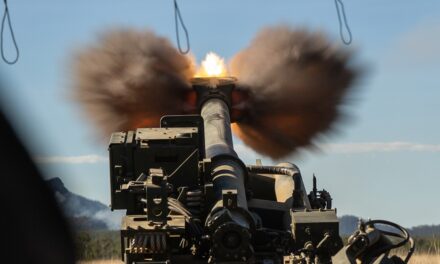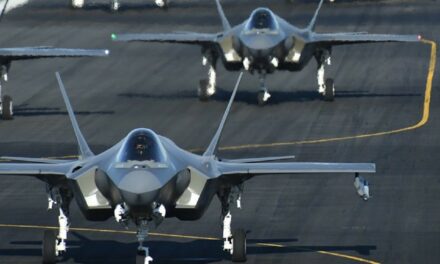We support our Publishers and Content Creators. You can view this story on their website by CLICKING HERE.
Israel and Iran, who are in a state of a shadow war, came close to a confrontation this spring. Against the backdrop of the Israel-Hamas War, Iran’s Revolutionary Guard Corps became more directly involved in commanding various militant organizations across the Middle East, which Israel would not leave unanswered.
On April 1st, 2024, Israel directly attacked several high-ranking IRGC commanders in a compound next to the Islamic Republic’s embassy in Damascus, Syria. Wanting retaliation, the IRGC launched a substantial wave of Shahed drones on the night of April 13th into the 14th.
The Missile and Drone Swarm on April 13th/14th
Assessing various options to attack Israel directly, the Mullahs ordered a large-scale suicide drone attack, supplemented by medium-range ballistic missiles, on April 13th. Reportedly conducting back channels with countries such as America and France, Iran stated their assets would not be targeted in their strike on Israel.
The Shahed 136 drones, which take up to several hours to pass through Iraqi, Syrian, Jordanian, and Saudi airspace, gave Israel and coalition partners substantial time to prepare for the attack.
American and British planes were airborne instantly, taking out numerous drones along with the US Navy destroying ballistic missiles through Aegis systems. The Kingdom of Jordan would also take down some drones and ballistic missiles, with one missile debris visible in the former.
Israel’s Arrow-3, David’s Sling, and Iron Dome conducted interceptions, and IDF Spokesman, Rear Admiral Daniel Hagari, would also praise France for their role in the defense, albeit not disclosing if French warplanes fought directly or if Paris supplemented radar capabilities.
Drone and some missile launches also took place from Houthis-controlled areas in Yemen and Hezbollah-dominated Southern Lebanon. Still, the multi-pronged attacks were ineffective, as an interception rate of 99% was recorded.
What it Says About Iran’s Capabilities
The Islamic Republic’s missile capabilities are substantial. Despite being surrounded by unfriendly neighbors, the IRGC showed that they could conduct multi-pronged attacks from their soil along with calling up various proxies in the region.
Despite publicly broadcasting a retaliation, Iran’s intelligence apparatus found a way to launch hundreds of drones and missiles with disruption from their Westernmost province. Nonetheless, the Islamic Republic stated it gave neighboring countries a time frame for retaliation, giving a window for regional defense maneuvers.
Iran’s threatening medium and long-range ballistic missiles can reach the majority of the Middle East along with much of North Africa, the Caucasus, and Southwest Asia. With rigid terrain that helps conceal missiles, the IRGC has a formidable geography and offensive capabilities.
Outside of Iran, proxies, such as Hezbollah, Hamas, Houthis, and Iraqi and Syrian militias, were reluctant to conduct a full-scale measure against Israel—not to draw a significant Western response. Nevertheless, Hezbollah, Iran’s most prominent and strongest proxy, currently has capabilities of the IRGC and can be considered as an extended branch of the Guard Corps.
Having Iranian-made missiles and drones that could strike all areas of Israel, including nuclear power plants, the Lebanese militia could fire upwards of 2,000-5,000 missiles a day if Israel and Hezbollah are embroiled in a full-scale war again.
What it Says About Israel and Allied Capabilities
The Allied and Israeli response to the mass swarm was a major success. Over 185 drones, 20 ballistic missiles, and 36 cruise missiles were all launched at Israel, with the overwhelming majority being shot down by various countries.
Coordination between Western powers such as America, Britain, and France to conduct joint operations with Middle Eastern allies such as Israel, Jordan, and Saudi Arabia is essential for growing regional capabilities to counter adversaries.
The British Royal Air Force (RAF) maintains a critical quick reaction time for all military scenarios from their sovereign Akrotiri Air Base in Cyprus. The Mediterranean island nation of Cyprus will also be the potential starting point of the humanitarian port mission for aid to Gaza.
Israel’s Arrow 2/3, David’s Sling, and Iron Dome had a near 99% interception rate with the few missiles that passed through, hitting empty areas of the Dead Sea, minor damage to a military runway, and only one village, mortally wounding a Bedouin child.
Israel will continue to enhance its missile defense capabilities, which have become a hot commodity in global exports in the defense market. Countries such as Finland, Romania, and Poland have recently procured Israeli air defense systems.
A Further Case Study to be Used in Conventional Warfare
The measured defensive response against the Islamic Republic’s missile and drone barrage is essential for the future of conventional warfare. Reaction timing made by the Central Command can show lessons for various regions.
The Middle East currently has one of the strongest multilayered air defense systems, with various THAAD and Patriot systems located in multiple MENA countries, supplemented by Aegis from US Naval Forces.
The high interception rate by the US and allied countries in the region could bring valuable battle damage assessments (BDAs) to East Asia, where US forces and partnered countries look to counter China and North Korea. Ballistic missiles from Beijing and Pyongyang are some of the world’s deadliest, and having a high interception rate against the IRGC brings further confidence.
Layered air defense systems located in Japan, South Korea, Taiwan, and the 7th Fleet will give the US a solid defensive measure for China’s intermediate-range missiles, as a war on the Taiwan Straits would overwhelmingly involve naval and air superiority.
Regarding the ongoing Israel-Iran shadow war, the Israeli defense cabinet may be more inclined to go for the ‘head of the octopus’ (the IRGC) instead of the tentacles (Iranian proxies), as former PM Naftali Bennett suggested. For now, President Biden is trying to dissuade Israel from a counter-strike. Still, it is unknown if PM Netanyahu will listen—especially as both heads of state have clashed recently.
Iran’s missile and drone attack gave the US, Israel, and various allied countries valuable combat data and lessons for the future of missile defense and crisis management—particularly for any conflict in East Asia. However, we must be aware unlike Iran, an attack from adversaries such as China, North Korea, and Russia will come without warnings and delays.
About the Author: Julian McBride
Julian McBride is a forensic anthropologist, SOFREP contributor, and independent journalist born in New York. He reports and documents the plight of people around the world who are affected by conflicts, rogue geopolitics, and war, and also tells the stories of war victims whose voices are never heard. Julian is the founder and director of the Reflections of War Initiative (ROW), an anthropological NGO which aims to tell the stories of the victims of war through art therapy. As a former Marine, he uses this technique not only to help heal PTSD but also to share people’s stories through art, which conveys “the message of the brutality of war better than most news organizations.”

 Conservative
Conservative  Search
Search Trending
Trending Current News
Current News 





